Last Updated: October 26, 2023
Common Mistakes to Avoid When Paying Off Debt

Disclaimer: We are not qualified legal or tax professionals and are not giving advice. Always speak with a qualified professional before making any legal or financial decisions.
It’s likely that you only use credit cards to make everyday purchases. People don’t often carry around cash anymore simply because credit cards are more convenient. You might even have several cards for specific stores.
You make payments here and there and wonder why all the sudden, you’re thousands of dollars in debt. $40 on gas + $100 on groceries + $5 on coffee + $15 on lunch during the week will definitely add up. I can also bet that you’re not just at the coffee shop or sandwich stand next door once a week.
Then take that credit card debt and add it to your car payments, student loans and mortgage and you’re likely drowning in all the numbers next to that dollar sign. There are several ways to pay off your debt, including understanding the essentials of a Debt Management Plan.
Some methods are more effective than others. If several years have gone by and you’re still making payments on credit cards and loans, you’re probably doing something wrong.
Here are some of the common mistakes people make when paying off debt and how you can get out of that trap as soon as possible.
You don’t have a plan
It’s great that you are putting payments on your credit cards, but without a smart plan, you won’t really see your efforts pay off as much as they can. If you have several credit cards, it’s smart to make a list before you tackle them.
Write down the credit card name, balance due, interest rate, minimum payment and due date. Some people have made the mistake of putting the minimum payment on all their cards or focusing on the credit card with the most balance.
While this is a plan, it’s not the best one. Instead, focus on the card with the highest interest rate as that the one worth paying off first and the pay the minimum on the rest of your cards until you can solely focus on them. You’ll pay off your debt quicker in the long run when you’re paying off bigger amounts on a single card.
Mainly focusing on one balance also makes your debt seem less overwhelming as opposed to throwing $50 here and there on multiple cards at the same time.
The "debt avalanche" method is focusing your extra payments on the debt with the highest interest rate first. This method will save you the most money overall compared to other debt repayment strategies.
The key steps are:
- List all your debts from highest to lowest interest rate.
- Pay minimums on everything except the debt with the highest rate.
- Put any extra money toward paying off the highest rate of debt first.
- Once that's paid off, roll that payment amount to the debt with the next highest rate.
- Repeat until all debts are paid off.
The avalanche method and other strategies from our essential guide mean you pay off debts faster and pay less interest overall.
You’re missing payments
While you’re devising your plan and looking into comprehensive financial planning, set up all your accounts to automatically pay by the due date This will ensure that you’re not hit with late payments. If you know exactly how much will be coming out of your bank account and when, it’ll be easier to make sure you have the right amount of funds for that payment every time.
You can even change the payment dates to work around your paychecks. Noting all of your debt information on paper or on a spreadsheet will help you see things in a bigger picture so you’re prepared every month.
If you are charged with a late fee, call the credit card company and kindly ask if they will waive it for you. They’ll be more likely to reverse the fee if you tell them you’ll be setting your account to automatic payment, if this is your first late fee or if you’ve been a long time valued customer. It never hurts to ask.
You keep a balance on your cards to build credit
Keeping up your credit score should definitely not be a priority over paying off your debt and it’s likely that your good credit score got you into this debt in the first place. Carrying a balance on your card each month that you’re being charged interest for is actually ruining your credit.
Pay off your debt now and stop worrying about hurting your credit score . There are several ways to boost your credit when it’s time, but for now, paying off these cards should be number one on your list. Also keep in mind that just because you have a high limit on your credit card doesn’t mean you should be maxing it out.
A $15,000 credit limit does not equate to a shopping spree. In fact, you should be keeping your utilization rate low and your balance should not exceed 30% of your credit limit. For example, a card with a limit of $15,000 should never have more than a $4,500 balance. Doing this will definitely protect your score later.
Carrying a balance does not help your credit score because it increases your credit utilization ratio. This ratio compares your total credit card balances to your total credit limits.
Experts recommend keeping your utilization below 30%. The lower the ratio, the better your score. Carrying a balance likely pushes your utilization over 30%, hurting your score.
You’re putting it off until you make more money
“When I make more money, I’ll pay this card off. When I make more money, I’ll clear all my debt. When I make more more money, life will be great.” Well when will that be? The time is now.
The longer you procrastinate paying off your debt, the more debt you’ll be in. Simple as that. An emergency might come up. Your company might downsize. You might decide to pursue a different career and end up working a lower paying job until you learn the ropes.
Who knows what can happen, but you don’t want to have all this debt acquiring on top of it all. Start paying off as much as you can starting now. If you put off paying off a credit card with a $5,000 balance and 18% APR,
Here is how the balance would grow over time only by making minimum payments:
- 1 year later: $5,400
- 2 years later: $5,800
- 5 years later: $7,100
Paying more than the minimums or paying off the balance early prevents interest from accruing and largely grows the debt over time.
You don’t know your options
You don’t know all the options available to you when managing your debt and suck paying a high balance on loans you simply cannot afford right now? Got a balance with high interest rates? You have options and asking what they are is where you can start.
If you’re paying off student loans and don’t make enough money to pay the monthly payments, don’t have a job as a recent graduate or recently got laid off, you can request a deferment or forbearance for a certain amount of time. Stopping payments on student loans for now can help you focus on your other debt.
Refinance your car to reduce the amount you pay each month, reduce your interest rate and change the length of your loan. Also ask your credit card company if you can reduce the interest charge on your monthly payment. Some companies will grant this request if you’ve been a loyal customer who makes payments on time.
It also helps if you have a good credit score or if it has recently improved. These companies want to keep you as a customer so simply request a lower interest rate and hope for the best.
Other debt relief options include:
- Balance transfers - pros are 0% intro APR, cons are balance transfer fees and expiration of intro rate.
- Personal loans - pros are fixed rates and terms, cons are origination fees and credit score impact.
- Credit counseling - pros are customized plans and advice, cons are program fees.
When considering options, weigh eligibility (credit score, income level, etc.) and costs vs. benefits.
You always give into your friends’ invitations
We’re not telling you to live like a hermit crab until you’ve zeroed out all your cards and loans, but you need to be smart about where you go out and how often. As much as you want to and as hard as it is to break bad habits, don’t accept every invitation your friends throw your way.
Lunch here, coffee there, brunch on weekends and happy hour during the game can cost you hundreds of dollars a month when you add it all up. Plan accordingly, choose the events and be ready to decline if it’s something you can’t afford to do. Only try going out to celebrate your friends’ special occasions like birthdays and anniversaries and avoid the random “Wanna grab a drink?” invites.
If your colleagues always go out for lunch on Fridays and you don’t want to miss out, vow to eat a packed lunch for the rest of the week and choose an affordable option on the menu. If you’re invited to watch the game at a bar during happy hour, eat at home first and you won’t be tempted to order something at the restaurant. You also don’t need to order a drink to enjoy the game.
Be smart and disciplined (almost like you’re on a diet). When you’re on a diet, you watch what you eat, you create a meal plan, resist temptation and create incentives when you achieve your goals, like if you lose 10 lbs. in 2 months, you’ll buy new workout shoes. When you’re on a spending diet, you need to decide what’s a necessity and what’s a splurge.
Create incentives the same way and treat yourself without breaking the bank. For example, for every $1,000 you pay off, reward yourself with a Netflix binge, a drive to the beach, a homemade pancake breakfast or a lazy day to sleep in and do absolutely nothing. Having a reward system for your goal to pay off debt can help you achieve it faster.
Budgeting Tips
Creating a budget is essential to getting your debt under control.
Here are some tips:
- Categorize your expenses. Be sure to include things like housing, transportation, food, utilities, debt payments, and discretionary spending money.
- Use apps like Mint or spreadsheets to track where your money is going each month. Identify areas of overspending.
- For variable expenses like food and entertainment, establish a reasonable monthly budget cap based on your income and don't exceed it.
- Build "buffer" categories like savings and investments into your budget so you have a cushion and are planning ahead.
- Set up automatic transfers to have a portion of your paycheck go directly into savings. This removes the temptation to overspend.
- Re-evaluate your budget frequently and adjust categories as needed. Your situation may change month-to-month.
- If you are a couple, make sure you are on the same page with budgeting and have open communication.
Debt Repayment Calculator
- Embed a debt repayment calculator tool so readers can estimate how long it will take them to pay off their debt with a customized repayment plan.
- This calculator would allow users to input their total debt amount, interest rates, and proposed monthly payments.
- It would then calculate and display the number of months to pay off the debt in full, total interest paid, monthly payment needed to pay off debt in 1, 2, or 3 years, etc.
- Having this tool lets readers create their own customized debt repayment plan.
Success Stories
Here are some inspirational success stories from real Pacific Debt clients:
- Pacific Debt will be the company to get my debt resolved - This client had $125,000 in debt and struggled with creditors calling daily. After working with Pacific Debt, the client is now debt-free aside from his mortgage.
- Debt relief success story – We saved Lee thousands of dollars - Lee had $40,000 in credit card debt with high-interest rates. Pacific Debt negotiated with its creditors to lower interest rates and create an affordable monthly payment. In the end, Lee saved over $11,000.
Reading first-hand stories from others who succeeded can provide inspiration and hope. If you are struggling with debt, know that there are solutions, and achieving financial freedom is possible.
It’s not a priority
Having large amounts of debt can be extremely detrimental to many factors in your life. It can affect you buying a house, buying a car, going on vacations, changing your career, opening up a business or going to grad school. It can even cost you landing your dream job as a larger percent of employers check your credit along with running a background check.
According to a 2012 study from the Society for Human Resource Management, 47% of U.S. companies conduct credit checks and if they see that you have poor credit history, have missed payments, filed bankruptcy or have large amounts of debt, it could cost you the job.
Your life will benefit greatly when you learn how to manage your money, pay off cards in full and on time, and experience what it’s like to live debt-free. It’ll feel like a huge weight has been lifted off your shoulders and you could be a lot closer to it than you think.
Just make paying off debt a priority, cut out the bad habits that are costing you money , make a plan, find out your options and be disciplined. This can be hard, but it can be done. You just have to start somewhere. Don’t let debt run your life and the sooner you start paying if off, the sooner you can start living your life to the fullest.
FAQs
Conclusion
Getting out of debt can feel overwhelming, but taking it step-by-step makes it much more manageable. Avoid common mistakes like not budgeting, relying only on minimum payments, and ignoring interest rates. Instead, create a detailed debt payoff plan, explore ways to lower your rates, set a realistic budget that still brings happiness, and don't be afraid to ask for help. Celebrate small milestones along the way to stay motivated.
Focus on developing positive financial habits for the long term. With strategic effort, you can become debt-free and transform your financial situation. The journey starts with learning from others' experiences. Now that you know what not to do, you can make progress toward financial freedom.
If you are struggling with overwhelming debt and want to explore your debt relief options, Pacific Debt Relief offers a
free consultation to assess your financial situation. Our debt specialists can provide objective guidance relevant information and support to help find the right debt relief solution.
*Disclaimer: Pacific Debt Relief explicitly states that it is not a credit repair organization, and its program does not aim to improve individuals' credit scores. The information provided here is intended solely for educational purposes, aiding consumers in making informed decisions regarding credit and debt matters. The content does not constitute legal or financial advice. Pacific Debt Relief strongly advises individuals to seek the counsel of qualified professionals before undertaking any legal or financial actions.
Reduce Your Credit Card Debt By Up to Half

BBB Reviews | 4.9/5.0 Rating









 Do Not Sell My Personal Information
Do Not Sell My Personal Information